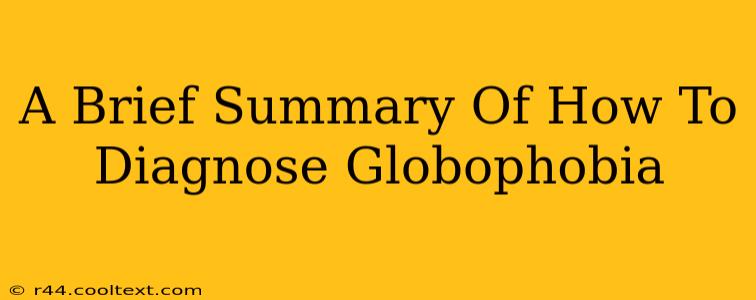Globophobia, the fear of balloons, isn't a formally recognized phobia in the Diagnostic and Statistical Manual of Mental Disorders (DSM-5). However, it falls under the broader category of specific phobias, which are diagnosed based on a pattern of symptoms and behaviors. While there's no specific "globophobia test," a mental health professional can assess if your fear of balloons meets the criteria for a specific phobia.
Understanding the Diagnostic Process for Specific Phobias (Including Globophobia)
Diagnosing any phobia, including a fear of balloons, involves a comprehensive evaluation by a qualified professional like a psychiatrist, psychologist, or therapist. The process generally includes:
1. Clinical Interview: The Cornerstone of Diagnosis
The initial step involves a thorough conversation. The professional will want to understand:
- The nature of your fear: How do balloons make you feel? What specific aspects trigger your anxiety (the sound of popping, the visual appearance, the size, etc.)?
- The intensity of your fear: How debilitating is your fear? Does it significantly impact your daily life, social interactions, or work/school?
- The duration of your fear: How long have you experienced this fear? Understanding the onset and progression is crucial.
- Associated symptoms: Do you experience physical symptoms like rapid heartbeat, sweating, shortness of breath, trembling, or nausea when exposed to balloons? These are common anxiety responses.
- Avoidance behaviors: Do you actively avoid situations where you might encounter balloons? This avoidance is a key indicator of a phobia.
2. Assessment Tools: Supplementing the Interview
While not always necessary, professionals may use standardized questionnaires or rating scales to quantify the severity of your fear and anxiety. These tools provide objective measures to support the clinical judgment.
3. Ruling Out Other Conditions: Differential Diagnosis
It's vital to rule out other conditions that might mimic the symptoms of a phobia. For example, a panic disorder could produce similar physical symptoms. The professional will carefully assess your overall mental health to ensure an accurate diagnosis.
Meeting the Diagnostic Criteria for a Specific Phobia
To be diagnosed with a specific phobia (including a fear of balloons, if severe enough), the individual must experience:
- Marked fear or anxiety about a specific object or situation (in this case, balloons).
- The phobic object or situation almost always provokes immediate fear or anxiety.
- The phobic object or situation is actively avoided or endured with intense fear or anxiety.
- The fear or anxiety is out of proportion to the actual danger posed by the specific object or situation and to the sociocultural context.
- The fear, anxiety, or avoidance is persistent, typically lasting for 6 months or more.
- The fear, anxiety, or avoidance causes clinically significant distress or impairment in social, occupational, or other important areas of functioning.
Seeking Professional Help
If your fear of balloons significantly impacts your life, seeking professional help is recommended. A therapist can help you develop coping mechanisms and treatment strategies, such as exposure therapy or cognitive-behavioral therapy (CBT), to manage your globophobia. Remember, getting a diagnosis is the first step towards effective treatment and a better quality of life.

